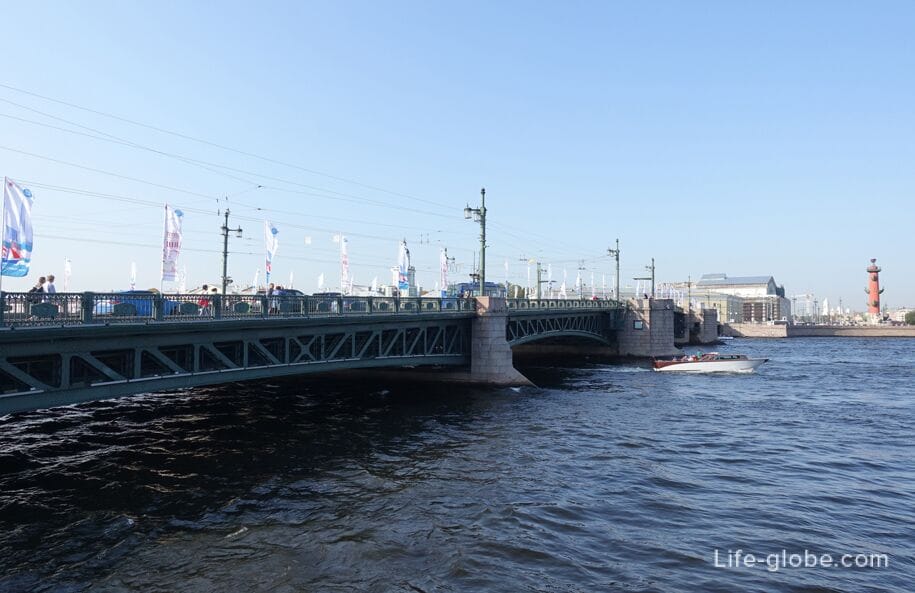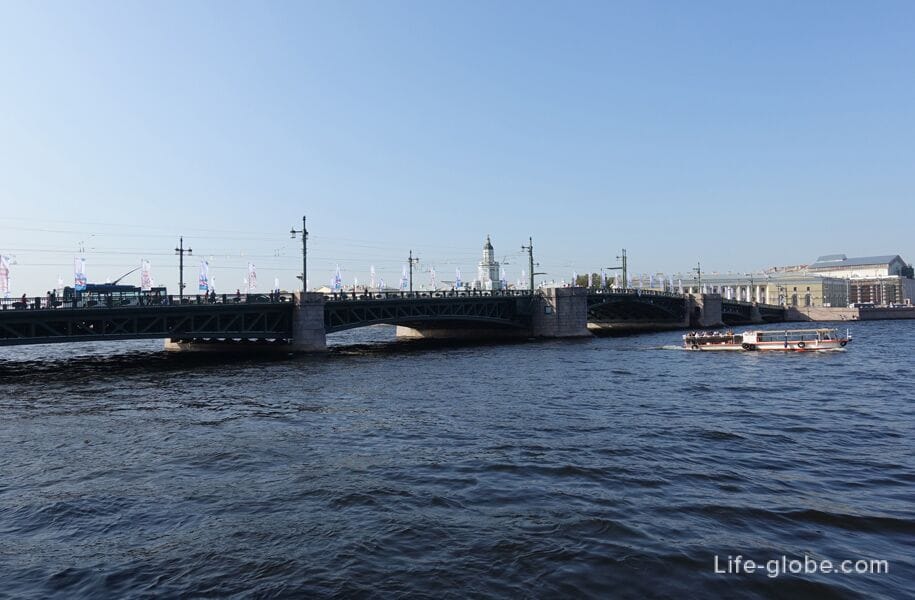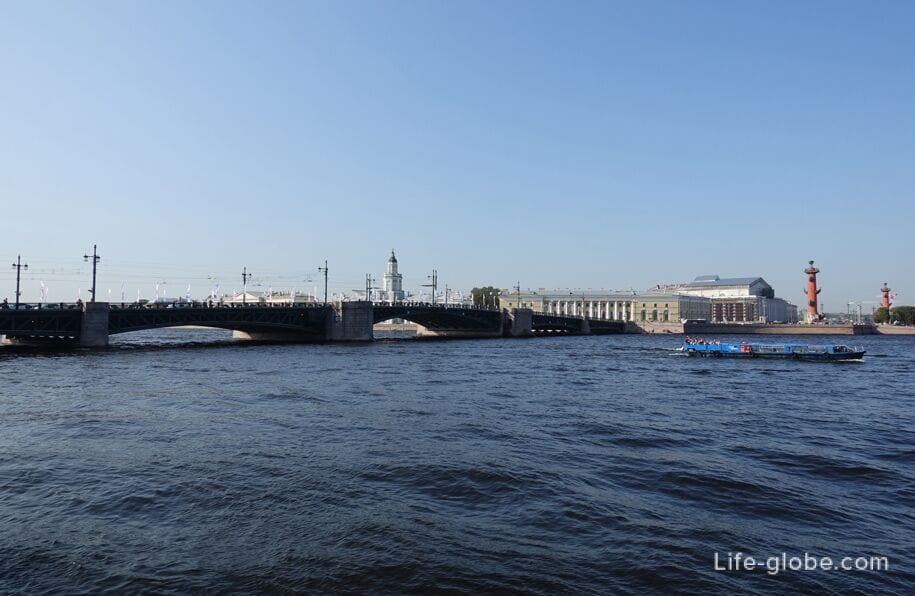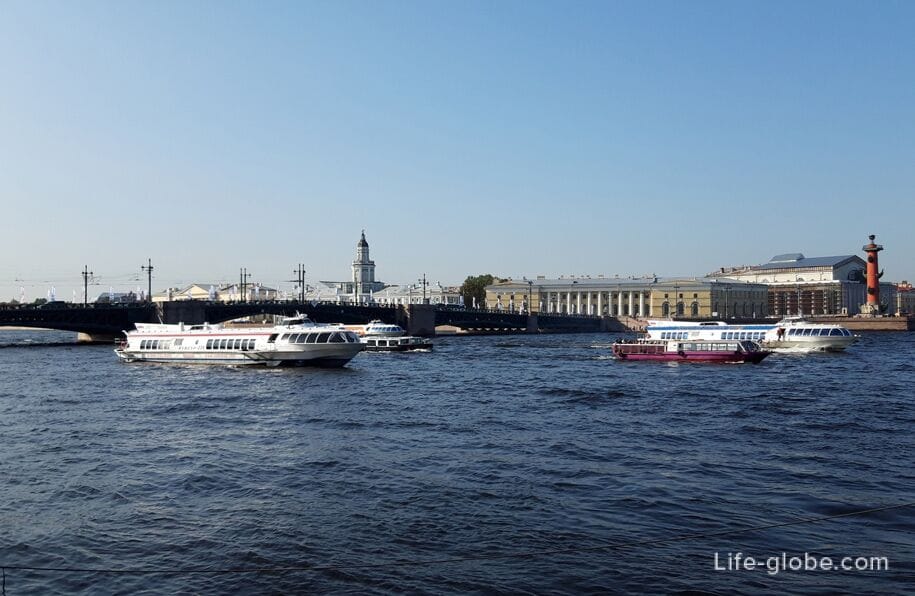
The Palace Bridge is one of the bridges over the Neva River (Bolshaya Neva) in St. Petersburg.
The Palace Bridge is one of the most majestic bridges in St. Petersburg, and from the point of view of engineering - it is one of the most complex structures not only in Russia, but also abroad.
The popularity of the bridge is also given by the fact that the Palace Bridge is a drawbridge.
The Palace Bridge connects the central part of St. Petersburg-Palace Square (Admiralteiskaya and Dvortsovaya embankments) and Vasilievsky Island.
The total length of the bridge is 267.5 meters, and its width is 31.6 meters.
The bridge is a roadway and pedestrian. The central part of the bridge-passing in both directions. On both sides of the bridge there are pedestrian sidewalks, fenced with railings. The bridge is illuminated by 28 lanterns mounted on 16 pillars.
Upstream from the Palace Bridge is Trinity Bridge, downstream-Blagoveshchensk Bridge.
The name of the bridge "Palace" comes from the nearby Palace Square and Palace Embankment.
View of the Palace Bridge from the Palace Embankment




View of the Palace Bridge from the Admiralty Embankment (Palace Pier)



One of the most popular sights in St. Petersburg is the drawing of bridges.
In total, 9 bridges are regularly built in the city, and three more on preliminary applications.
Bridges in St. Petersburg are built regularly, annually - from April to November, at night.
The first to be built is the Palace Bridge, the construction of which is a popular and photographed event. Most people come to see the divorce of this bridge. The Palace and Admiralteiskaya embankments can be so crowded that they can't be crowded. People sometimes come about 40 minutes before the bridge is opened.
The divorced Palace Bridge is one of the symbols of the city and its image can be seen on postcards, magnets and souvenirs.
The Palace Bridge is a five - span bridge. The central two - winged draw span is 56.5 meters wide, one of the largest in the world. The weight of metal span structures is 4868 tons, counterweights-2800 tons.
The bridge is raised using a modern hydraulic system. The entire wiring cycle takes 5 minutes, and the bridge is built in the same time. Read more about the divorce of all bridges in St. Petersburg (with photos)…
The time of bridge construction may vary. We recommend that you check the exact time of the bridges in St. Petersburg, including the Palace Bridge, on the official website: mostotrest-spb.ru.


On the days of some summer film festivals, the Palace Bridge turns into a huge open-air cinema-the wing of the divorced bridge on the side of the Hermitage plays the role of a screen with an area of more than 400 square meters.
The first crossing in this part of the city appeared in 1727 - it was the floating St. Isaac's Bridge (now not preserved), located just downstream from the current Palace Bridge, between the buildings of the Senate and the Synod and the Menshikov Palace. The bridge consisted of wooden plashkout barges and was temporary: the bridge was built during navigation, and in winter it was crossed over the ice of the Neva River.
Later, at the request of the townspeople, the St. Isaac's Plashkout Bridge was moved to the Winter Palace, where a boat ferry has operated since then.
The Plashkoutny Palace Bridge worked all year round. In 1863, the horse-drawn railway opened. Rails were laid across the bridge. The tram and then the tram ran on the Palace Bridge until 1997.
Due to the fact that the bridge plashkouty began to leak and sink, by the end of the 19th century, the authorities of St. Petersburg decided to build a permanent crossing. A competition was announced for the design of the new bridge, the winner of which was recognized as the project of engineer Andrey Pshenitsky and architect Robert-Friedrich Meltzer.
The construction of the new Palace Bridge began in October 1911, and the opening was planned for November 1913. However, the construction was delayed - in April 1914, the flood prevented the work, then the First World War began.
The bridge was built by the end of 1916. The first carriage passed over the Palace Bridge on December 23, 1916. This date is considered the official birthday of the Palace Bridge.
Because of the war, the bridge was commissioned without architectural decoration. Railings, lanterns and control pavilions were already installed under the Soviet regime. So, the cast-iron grating of the bridge with stars and banners appeared only in 1939. The authors of the grid were the sculptor Igor Krestovsky and the architect Lev Noskov.
From 1918 to 1952, the bridge was named Republican.
In the future, repairs and improvements to the bridge were carried out, including replacing the wooden parts of the bridge with more durable materials.
In 1997, the tram tracks were removed from the bridge, and night lighting was installed. In honor of this event, on November 14, 1997, the festival "Palace Bridge lights up the lights"was held. The lighting was turned on to the sound of a cannon salvo from the Peter and Paul Fortress, fireworks and ballroom dancing took place on the bridge in old costumes.
The drawbar mechanism from the opening of the bridge until the reconstruction in 2012-2013 was electromechanical. After that, the drawbridge underwent a complete modernization: the drawbridge was equipped with a modern hydraulic system. At the same time, rivets from tsarist times have been preserved on the non-movable parts of the Palace Bridge.
All accommodation facilities in St. Petersburg, including in the city center and more remote from it, can be viewed and booked here